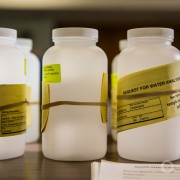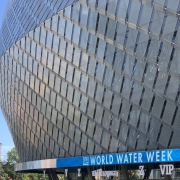EPA Says It Will Regulate Two PFAS Chemicals in Drinking Water
The agency’s PFAS action plan includes steps for regulation, monitoring, detection, and cleanup.

Toxic PFAS chemicals have been detected at dozens of groundwater sites across Michigan. Photo © J. Carl Ganter/Circle of Blue
By Brett Walton, Circle of Blue
- The EPA will complete the first step in the regulatory process for PFAS in by the end of 2019
- The EPA has not set a new Maximum Contamination Level since the Safe Drinking Water Act was revised in 1996
- Environmental groups called the EPA’s timeline too slow and responses too timid or limited
- In the absence of federal rules, several states have set their own drinking water standards
The U.S. Environmental Protection Agency will set federal drinking water standards for PFOA and PFOS, two manmade chemicals in a class of toxic compounds that have been found in the water supplies of millions of Americans.
Don’t expect the standards to come quickly, though.
In a rollout on February 14 of its plan for addressing nationwide PFAS contamination, Andrew Wheeler, the acting EPA administrator, said that the agency will complete the first step in the regulatory process by the end of the year. That first step is an official determination of whether to regulate the chemicals, which Wheeler said the agency would do.
“I have every intention of setting an MCL,” Wheeler said at a press conference in Philadelphia, using the technical abbreviation for a drinking water standard. The agency currently has in place a 70 parts-per-trillion health advisory for PFOA and PFOS, which is not enforceable.
Finalizing the standards could take years, though Wheeler would not commit to a timeline. The agency could say by the end of the year that it intends to regulate PFOA and PFOS but not issue a proposed standard until later.
“EPA has not made final decisions regarding the scope and content of that [regulatory determination]. Commenting on the content of the proposal is not appropriate at this time because it would be predetermining the regulatory process,” Maggie Sauerhage, an EPA spokesperson wrote to Circle of Blue in an email.
The EPA has not set a new MCL since the Safe Drinking Water Act was revised in 1996, “so we’re charting new territory,” Wheeler said. The agency determined in 2011 that it should regulate perchlorate, an ingredient in explosives, but it still has not proposed a standard.
Drinking water standards for PFOA and PFOS are one component of the agency’s broader plan for responding to the toxic chemicals used in firefighting foams, nonstick cookware, and waterproof materials. Because of strong molecular bonds that do not easily break down, PFASs, which number in the thousands, have garnered the nickname “forever chemicals.” They have been linked to kidney cancer, high cholesterol, thyroid disease, and other ailments.
The EPA developed the plan after a year of barnstorming the country, holding public meetings in seven states.
Other actions mentioned in the plan include:
- Listing PFOA and PFOS as hazardous substances under the federal Superfund law. Doing so will give the agency the authority to order cleanups at contaminated sites and force polluters to cover the cost.
- Publishing groundwater cleanup standards for PFOA and PFOS. These standards are currently in interagency review, according to David Ross, head of the EPA Office of Water.
- Monitoring for additional PFAS chemicals in the next round of national drinking water monitoring, which will begin after 2020.
- Assessing the toxicity of five additional PFASs by 2020.
- Developing new analytical tools for detecting the chemicals in water.
- Considering whether to require companies to disclose in mandatory reports the amount of PFASs that they discharge to water, air, or land. Currently no such chemicals are on the annual Toxics Release Inventory.
The EPA plan was quickly criticized for a number of deficiencies.
Environmental groups called its timeline too slow and responses too timid or limited.
The Environmental Working Group said the agency should immediately prohibit new PFAS chemicals in commerce. Besides a drinking water standard, EWG also recommended adding PFASs to the Toxics Release Inventory and listing them as hazardous substances.
Other groups worried about the sense of urgency.
“While the agency fumbles with this ‘mis-management plan,’ millions of people will be exposed to highly toxic PFAS from drinking contaminated water,” said Erik Olson, senior director for Health and Food at the Natural Resources Defense Council, in a statement.
Wheeler said that the long timeline was needed in order for the agency to do a thorough job.
“None of these processes can be done overnight. We have to make sure they can stand up in court,” Wheeler said.
Rep. Dan Kildee, a Michigan Democrat, and Rep. Brian Fitzpatrick, a Pennsylvania Republican, are the co-chairs of the Congressional PFAS Task Force. Both represent districts where the chemicals have contaminated drinking water. They said that EPA actions must match the scale of the problem.
“While today’s announcement is a start, further aggressive and impactful actions must be taken by the Administration to protect Americans’ communities,” they said in a joint statement.
The National Rural Water Association, which represents water utilities that serve fewer than 10,000 customers, objected to a federal standard.
Mike Keegan, the association’s policy analyst, told Circle of Blue that the EPA should use carrots instead of sticks for small utilities that are already struggling with the expense of operating their water systems. Carrots in this case being paying for testing and monitoring water samples, grants for constructing treatment units, and technical guidance for operating new equipment.
The stick, which the agency says it will choose, is a federal drinking water standard. A standard requires utilities to monitor water supplies for the presence of the chemical and remove it, or face fines for non-compliance. But, Keegan notes, federal standards are not set solely on public health considerations. They are a compromise between health protection, technological capacity, and cost.
Cost concerns have led dozens of utilities, from Arizona and Alaska to New York, to sue chemical companies and the U.S. military in an attempt to recover municipal expenditures on cleanup and treatment.
Westfield, a city of 41,000 people in Massachusetts, for instance, filed a preliminary claim for $47 million in its lawsuit against firefighting foam manufacturers. Westfield had to shut down two of its eight wells and is using a third only for emergency purposes.
In the absence of federal rules, several states have set their own drinking water standards, or are in the process of doing so. Many of the state standards are stricter than the EPA’s health advisory.
New Hampshire regulators initiated rulemaking in January for four PFAS compounds. Proposed standards are 70 parts per trillion for PFOA and PFOS combined, 85 parts per trillion for PFHxS, and 23 parts per trillion for PFNA.
New Jersey, with a standard of 13 parts per trillion, is the only state so far to regulate PFNA.
In December, New York’s Drinking Water Quality Council, an advisory body, recommended standards of 10 parts per trillion for PFOA and 10 parts per trillion for PFOS. The state health commissioner must decide whether to adopt them.
Congress, meanwhile, has also moved to limit the spread of PFAS chemicals into the environment. Lawmakers passed a bill in October that allows commercial airport to discontinue use of firefighting foams that contain PFASs. Before it can go into effect, however, the Federal Aviation Administration must change its codes.
Brett writes about agriculture, energy, infrastructure, and the politics and economics of water in the United States. He also writes the Federal Water Tap, Circle of Blue’s weekly digest of U.S. government water news. He is the winner of two Society of Environmental Journalists reporting awards, one of the top honors in American environmental journalism: first place for explanatory reporting for a series on septic system pollution in the United States(2016) and third place for beat reporting in a small market (2014). He received the Sierra Club’s Distinguished Service Award in 2018. Brett lives in Seattle, where he hikes the mountains and bakes pies. Contact Brett Walton












Leave a Reply
Want to join the discussion?Feel free to contribute!